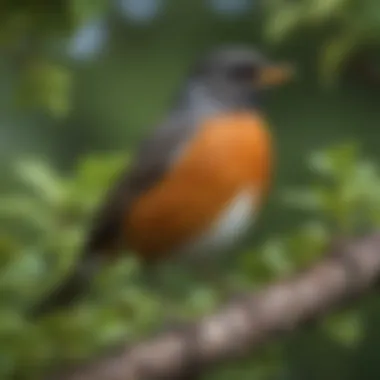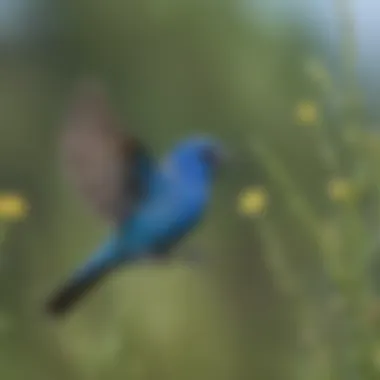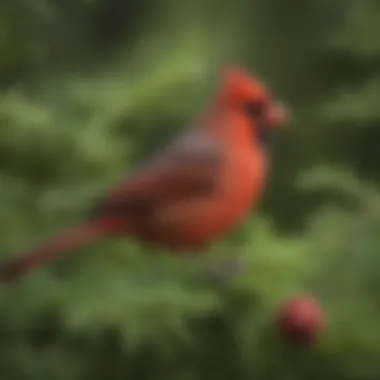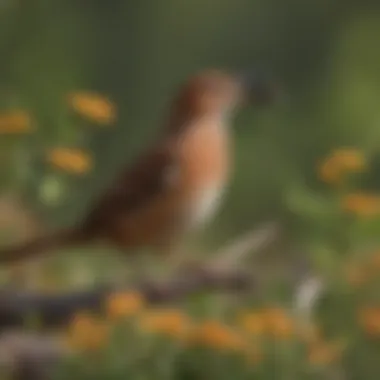Exploring Oklahoma's Enchanting Songbird Diversity


Intro
Oklahoma is home to a rich diversity of songbirds. The state provides various habitats that support these species, from grasslands to wooded areas. Understanding songbirds is crucial for appreciating the ecosystems they inhabit. This article will highlight their unique characteristics, behaviors, and the roles they play in the environment. It will also address conservation efforts to protect these vital animals.
Fascinating Facts About the Animal
Unique Characteristics
Oklahoma's songbirds exhibit remarkable features. Each species possesses distinct plumage, songs, and behaviors. For instance, the Northern Mockingbird can imitate over 200 different species of birds and other sounds. This ability aids in territory establishment and mate attraction.
Extraordinary Abilities
Many songbirds have extraordinary migratory capabilities. The Ruby-throated Hummingbird flies thousands of miles from Central America to North America every year. Such long-distance migration is not just a journey; it is a testament to their endurance and navigational skills.
Behavior and Habitat
Natural Habitats
Songbirds thrive in diverse habitats across Oklahoma. They inhabit forests, grasslands, wetlands, and urban areas. Each habitat offers specific food sources and nesting opportunities. For example, the American Robin prefers open fields where it can easily find food, while the Wood Thrush enjoys dense forests with plenty of leaf litter for foraging.
Social Structures
Social structures in songbird populations can vary widely. Some species, like the Blue Jay, are known to form complex social units. Others may be more solitary, especially during the breeding season. Vocal communication plays a significant role in their social interactions, helping to establish territory and strengthen pair bonds.
Recent Scientific Discoveries
Latest Research Findings
Recent studies reveal critical insights into the behaviors and biology of songbirds. Research published in journals indicates how environmental changes directly impact their migratory patterns. As habitats shift due to climate change, migratory pathways may also change, affecting their survival.
Breakthroughs in Animal Biology
Moreover, breakthroughs in genetic studies have identified the importance of genetic diversity in songbird populations. Increased genetic variation can lead to better adaptability and resilience in changing environments.
Cultural Significance
Animals in Folklore
Songbirds hold a special place in local folklore. Many Native American cultures consider specific songbirds as symbols of communication and connection with the spirit world. This cultural resonance highlights their importance beyond mere biological existence.
Influence on Art and Literature
In art and literature, songbirds inspire numerous works. Poets utilize their songs to symbolize freedom and joy, while artists often depict them to capture the beauty of nature. Such representations underscore their significance in human culture.
Understanding songbirds is essential for conserving biodiversity and ensuring ecological balance. By appreciating their roles, we can better engage in conservation efforts and protect their habitats.
Conservation initiatives are ongoing, focusing on habitat protection and raising awareness about the importance of songbirds. Protecting these birds ensures the health of ecosystems across Oklahoma and beyond. The more we learn about them, the better we can appreciate and safeguard their place in both nature and culture.
Preface to Oklahoma's Songbirds
The study of songbirds in Oklahoma holds considerable importance not only for the appreciation of these avian species but also for understanding the broader ecological implications of their presence. Oklahoma's rich and varied habitats make it a prime location for diverse songbird species, each adapted uniquely to the local environment. This article aims to provide a comprehensive understanding of these birds, their behaviors, ecological roles, and the challenges they face in a changing world.


Overview of Songbirds
Songbirds, commonly referred to as passerines, belong to the order Passeriformes. These birds are characterized by their vocalizations, which play a crucial role in communication, mating, and territory establishment. In Oklahoma, a variety of songbird species thrive, each exhibiting distinct traits and preferences. They range from the vibrant Eastern Bluebird to the ever-familiar Northern Cardinal. A key element in exploring these birds is understanding their physical characteristics, behavior, and how they interact with their habitats.
Some points to consider include:
- Diversity: Oklahoma is home to numerous species, making it a focal point for ornithological studies.
- Adaptations: Each species displays unique traits that enable it to survive and thrive in its specific environment.
- Behavior: Understanding the behavior of these birds can give insight into their role in the ecosystem.
Significance of the Region
Oklahoma's geographical position in the United States provides a unique intersection of ecosystems, which contributes to the diversity of songbird species. This region includes plains, forests, and wetlands, offering various habitats suitable for different songbirds. The interplay of these ecosystems fosters a rich biodiversity that enhances the ecological balance. The significance of songbirds in this context cannot be understated; they help control insect populations, pollinate plants, and contribute to seed dispersal.
"Songbirds are not merely aesthetic additions to the ecosystem; they are vital contributors to its health and diversity."
The understanding of songbird populations can also act as indicators of environmental health. Their migratory behaviors can reflect broader climatic trends and environmental changes. For families, veterinarians, and wildlife biologists, recognizing the ecological significance of these birds provides avenues for ongoing research, conservation efforts, and educational opportunities.
Common Songbird Species in Oklahoma
Oklahoma is home to a diverse range of songbird species, each with distinctive characteristics and behaviors. Understanding these common songbird species is crucial as they offer insights into the ecological health of the region. Their presence indicates the state of local habitats and biodiversity. Additionally, songbirds play important roles in pest control and pollination. They also enrich our lives with their songs and vibrant presence.
Eastern Bluebird
Physical Characteristics
The Eastern Bluebird is notable for its striking coloration. Males are adorned with brilliant blue feathers on their backs, while their underbellies are a warm, rusty orange. This vivid appearance makes them a popular subject for birdwatchers and photographers. Their size, averaging about 6.5 to 7 inches in length, is ideal for nesting in a variety of habitats. The charm of their appearance not only attracts attention but also contributes to their popularity in gardens and parks.
Behavior and Diet
Eastern Bluebirds primarily feed on insects and berries, demonstrating a diet that aids in controlling pest populations. They hunt for insects by perching on high branches and swooping down quickly, showcasing impressive aerial agility. This predatory behavior is beneficial not only for their survival but also beneficial for humans, as they help reduce insect populations naturally. However, their reliance on specific food sources can make them vulnerable during harsh winters when food is scarce.
Breeding Habits
Breeding for the Eastern Bluebird typically occurs in spring. They often choose tree cavities or birdhouses for nesting. Females lay between three to seven eggs, which they incubate for about two weeks. This choice of nesting site is advantageous, offering protection from predators. However, bluebirds face competition from cavity-nesting species, which can impact their breeding success, especially in areas with high bird population density.
Northern Cardinal
Identification
The Northern Cardinal is easily recognized by the male’s bright red plumage contrasted by the female’s softer brown tones with hints of red. Their distinctive crest and black mask around the beak add to their charm. This striking appearance makes them one of the most identifiable birds in Oklahoma. Their presence is cherished in gardens and yards, often bringing color and life to the landscape.
Song and Communication
Known for their melodic songs, Northern Cardinals communicate through a series of clear whistles and chirps. The vocalizations vary, serving different purposes, from attracting mates to warning of danger. The song quality contributes to their popularity among bird watchers, enhancing the experience of observing these birds in the wild. Their song can often be heard throughout various habitats, signaling their adaptability.
Habitat Preferences
Northern Cardinals prefer denser shrubbery and low trees, making them common in gardens and parks. They thrive in areas that provide ample cover for nesting and hunting. Their habitat choices are linked to their feeding behavior, as they often forage in low vegetation for seeds and fruits. Their presence in urban and suburban areas showcases their adaptability, although habitat loss threatens their populations in some regions.
Common Yellowthroat
Appearance
The Common Yellowthroat stands out with its bright yellow underparts and distinctive black mask. Males are especially bright, making them a vibrant addition to Oklahoma’s avian landscape. This striking appearance is beneficial for attracting mates, as visual displays play a role in their courtship behavior. However, this bright coloration can also make them more noticeable to predators.


Nesting Behaviors
Common Yellowthroats typically build their nests in thick vegetation, which provides safety from predators. They often prefer grasses or reeds near water sources. The construction of these nests involves weaving plant materials together, demonstrating their resourcefulness. Their specific nesting habits highlight the importance of maintaining healthy wetlands for their continued presence in the region. Yet, this dependence on specific habitats poses risks if wetland areas are disturbed.
Feeding Preferences
The diet of the Common Yellowthroat primarily consists of insects and spiders. They forage actively in vegetation, displaying a foraging habit that allows them to find food efficiently. This feeding behavior is beneficial for both the birds and the ecosystem, as they help control insect populations. However, their reliance on insects makes them susceptible to changes in insect availability, which could result from environmental shifts.
American Robin
Distinct Features
American Robins are recognized for their orange-red bellies and hearty bodies. Their size and coloration make them a common sight across various landscapes. This distinct appearance aids in identification, making them popular among bird watchers. Their adaptability allows them to thrive in diverse environments, ranging from urban settings to rural areas.
Migration Patterns
American Robins exhibit migratory behaviors, often returning to Oklahoma in the early spring after wintering in the southern regions. Their migration patterns are influenced by food availability and weather conditions. This seasonal migration plays a significant role in their life cycle, marking the change of seasons. However, factors like climate change can disrupt their migration routes, creating challenges for these birds.
Role in Ecosystem
American Robins serve as crucial players in their ecosystems. They aid in seed dispersal, promoting plant diversity. Additionally, they control insect populations, helping to maintain balance within their habitats. Their presence is often seen as a positive indicator of ecological health. However, competition for resources with other species can impact their populations, making conservation efforts vital for their continued success.
Migration Patterns of Oklahoma's Songbirds
Migration patterns of songbirds in Oklahoma represent a crucial aspect of their lifecycle and ecology. Understanding these patterns allows us to appreciate the adaptability of these avian species in response to environmental changes. Such knowledge is beneficial not only for wildlife biologists and conservationists but also for families interested in birdwatching and nature.
Seasonal Changes
Songbirds typically exhibit distinct migration behaviors that align with seasonal changes. In Oklahoma, migratory songbirds often arrive during spring to breed. This period, from March to May, sees a significant influx of species like the Eastern Bluebird and the Northern Cardinal. The arrival of warmer temperatures and plentiful food resources triggers these birds to return from their winter habitats in the southern regions.
As fall approaches, these songbirds begin their southward migration, aiming to escape the colder temperatures and scarce food supplies that Oklahoma experiences. This process is critical for their survival. It's interesting to note that migration can vary dramatically between species. For example, the American Robin may start its migration earlier in September, while others may linger longer.
Impact of Climate on Migration
Climate change plays a crucial role in shaping songbird migration patterns. Changes in temperature and precipitation can alter food availability and nesting habitats, which may lead to shifts in migration timing. Some studies indicate that warmer springs result in earlier migrations. This can have grave consequences if food sources do not align with early arrivals.
In addition, changing rainfall patterns can affect habitat quality in key migratory stopover sites. For instance, wetlands that provide essential resting and feeding grounds may dry up or flood unexpectedly.
Habitat and Conservation of Songbirds
The habitat and conservation of songbirds in Oklahoma plays a crucial role in the survival and well-being of these avian creatures. Various environments provide songbirds with essential resources for feeding, nesting, and protection from predators. Understanding these habitats helps in facilitating conservation efforts. Moreover, recognizing the threats they face is vital for effective preservation strategies. A deep examination of these elements can illuminate the intricate connections between birds and their environments in Oklahoma.
Natural Habitats in Oklahoma
Natural habitats in Oklahoma can be broadly categorized into three primary ecosystems: grasslands, forests, and wetlands, each hosting unique species of songbirds which contribute to the rich avifauna of the state.
Grasslands
Grasslands in Oklahoma are vast open areas where grasses are dominant, appearing as a unique ecosystem vital for songbirds. These areas provide abundant food sources and nesting materials. The height and density of grasses offer crucial concealment from predators. Grasslands are popular habitats for many songbird species like the Eastern Meadowlark, known for its distinctive songs. The main advantage of grasslands is their ability to support a diverse range of species due to the various microhabitats they create. However, intensive agricultural practices pose significant threats to these ecosystems.
Forests


Forests in Oklahoma offer a different environment compared to grasslands. They are rich in biodiversity, providing an array of resources for songbirds such as cover, food, and nesting sites. The layered structure of forests allows different species to occupy diverse niches; for instance, the Northern Cardinal thrives in the understory. Forests act as important habitats for migratory birds during seasonal changes. One downside is that urban expansion often leads to habitat loss, impacting the bird populations that rely on these spaces.
Wetlands
Wetlands are vital in Oklahoma’s ecosystems. They are usually found at the intersection of land and water, supporting many species, including songbirds like the Common Yellowthroat. Wetlands help filter pollutants and provide crucial water resources. Their unique feature is the presence of standing water, which attracts various insects, serving as food for songbirds. However, they face threats from drainage for agriculture and urban development, reducing their capacity to support local wildlife.
Threats to Songbird Populations
The threats to songbird populations in Oklahoma are numerous and largely stem from human activities. Urbanization, climate change, and pollution significantly impact their habitats and survival.
Urbanization
Urbanization leads to habitat fragmentation, which affects songbirds by isolating populations. The development of cities increases noise pollution, disrupting communication among birds. Urban settings often replace natural habitats with non-permeable surfaces, decreasing food sources. While urban greenspaces can provide some relief for the surviving wildlife, they are often not sufficient to replace lost habitats.
Climate Change
Climate change is dramatically reshaping habitats. It alters migration patterns and can disrupt breeding cycles and food availability for songbirds. Variability in temperature and precipitation can lead to habitat degradation. The ongoing changes may cause birds to modify their ranges, often leading them to areas where they face new challenges. It is vital to monitor these shifts to implement supportive conservation measures.
Pollution
Pollution affects songbird populations through direct and indirect methods. Pesticides can poison birds and decrease food availability by killing off insects. Heavy metals and chemical runoff from urban areas can contaminate habitats. Light pollution disrupts natural behaviors, including migration. Addressing pollution demands significant community and governmental action.
Cultural Significance of Songbirds
Understanding the cultural significance of songbirds is important for grasping their role in Oklahoma's natural and human landscape. These small, melodic creatures are not merely a treat for the eyes and ears; they echo deeper connections between nature and society. Their presence influences local customs, beliefs, and arts, creating a rich tapestry of interrelations that unites ecology with cultural identity.
Songbirds often symbolize freedom and beauty, inspiring various forms of expression. Beyond symbolism, they carry ecological messages crucial for conservation and education. By studying these birds, we not only gain insights into their lives but also reflect on our relationship with the environment.
Native American Perspectives
In Oklahoma, Native American tribes have long revered songbirds, integrating them into spiritual beliefs and traditional stories. Many tribes see these birds as messengers from the spirit world, carrying wisdom and teaching important lessons about harmony with nature.
For instance, certain stories describe songbirds as guardians of the earth, teaching respect for all living beings. These narratives promote an understanding of sustainability, echoing a cultural respect for ecosystems. The intricate songs of these birds are often featured in songs and dances, affirming their role in community celebrations.
Understanding these perspectives illuminates how deeply songbirds are woven into the cultural fabric of Native American identity. Their significance extends beyond the physical realm, portraying connections that resonate with dignity and respect for nature.
Songbirds in Literature and Art
Songbirds have also inspired artists and writers, adorning the pages of literature and the canvases of painters. In poetry and prose, they often symbolize themes like love, loss, and hope. These representations resonate with audiences, showcasing how songbirds articulate emotional experiences.
Artists have captured the vibrant beauty of these birds through various mediums, celebrating their intricate patterns and movements. Paintings and sculptures depict species like the Eastern Bluebird and Northern Cardinal, often highlighting their roles within the ecosystem.
Additionally, songs and folk tales incorporate the melodies of songbirds, emphasizing their timeless presence in human culture. Such artistic expressions underline the interconnectedness of nature and society, reminding us that these creatures inspire creativity and reflection.
"In the songs of birds, we find the echoes of our humanity, urging us to listen and to protect."
No matter the medium, the cultural significance of songbirds in Oklahoma is undeniable. As we explore the delicate intertwining of avian life and human creativity, we realize the ongoing importance of preserving these natural treasures.
End
Summary of Key Findings
In summary, the exploration of songbirds in Oklahoma reveals a fascinating interplay of species, habitats, and ecological roles. The diversity of songbirds, such as the Eastern Bluebird, Northern Cardinal, Common Yellowthroat, and American Robin, showcases distinct features, behaviors, and breeding habits that contribute to the rich avifauna of the region. Key findings highlight the importance of these birds in various habitats—grasslands, forests, and wetlands—and their significant role in controlling insect populations, pollination, and seed dispersal. Furthermore, the migration patterns of these songbirds reflect their adaptability and resilience in facing seasonal changes while shifting climate conditions challenge their survival.
The songbirds of Oklahoma play an integral role in the local ecosystem, contributing to biodiversity and serving as indicators of environmental health.
Importance of Continued Research
Continued research on Oklahoma's songbirds is critical for several reasons. First, understanding their habitats and migratory patterns enables effective conservation strategies. A comprehensive study of these birds can provide insights into how environmental changes affect their populations. Additionally, ongoing research can shed light on their responses to threats like habitat destruction, climate change, and pollution. Community awareness and education about these challenges foster a culture of conservation, encouraging involvement in local initiatives. Veterinarians, wildlife biologists, and families alike can benefit from insights that contribute to engaging with nature responsibly. Hence, investing in research concerning songbirds will not only aid in preserving these species but also enhance the overall biodiversity of Oklahoma.







